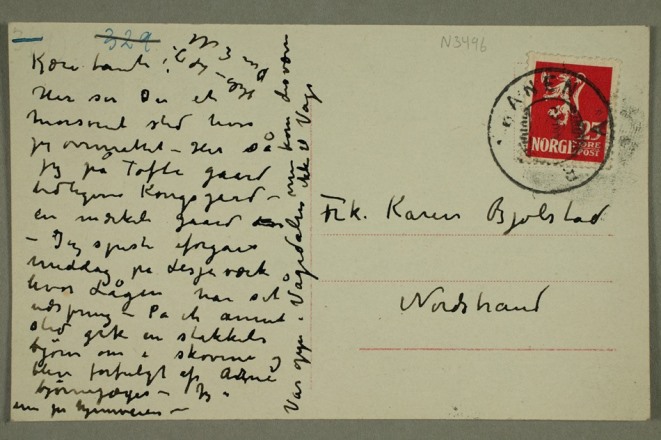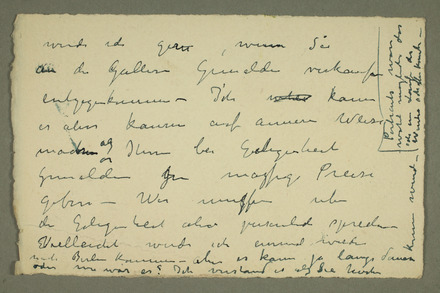Guidelines for the encoding of Munch’s texts – with examples
Hilde Bøe and Åshild Haugsland
Text structure. By “text structure” we mean the “image” of the text, i.e. paragraphs, headings, gaps, highlighting etc.
1 Paragraphs
Paragraphs are encoded using the <p> element. We define a normal paragraph as a block of text with an indent in the beginning of the first line. Deviations are encoded using the rend attribute. Note: Being a global attribute, the rend attribute can be used in all elements and in some of the examples below, the attribute is used in other elements than <p>.
rend="noIndent": used for paragraphs without first line indent. This value is also used when the first lines on a new page belong to a paragraph that started on the previous page. Oxygen demands <p> here, but as we do not want any indents here, we use rend="noIndent" in <p>. This system is also used for other elements that normally have a first line indent, i.e. <salute>. If the salute for some reason does not have an indent, we use rend="noIndent".
rend="noLineBreakBefore": used for blocks of text that are regarded as paragraphs, but for some reason do not have a preceding line break, i.e. when the first paragraph of a letter follows immediately after the salute/opener.
We choose to read “sympathetically”. Munch’s left margins bend and meander in a way that often makes it difficult to decide whether there is an indent there or not. When the context suggests that an indent is reasonable, we encode an indent – and vice versa: when an indent seems unlikely, we do not encode an indent/new paragraph. By ‘context’ we mean for instance the length of the previous line or narrative changes (i.e. from direct speech to expressed thoughts or that the narrative changes from first to third person). The encoding of paragraphs therefore involves some degree of text analysis.
The ordered structure helps the reader understand the text better than a strictly diplomatic transcription would have done.
2 Headings
Headings are encoded in the <head> element.
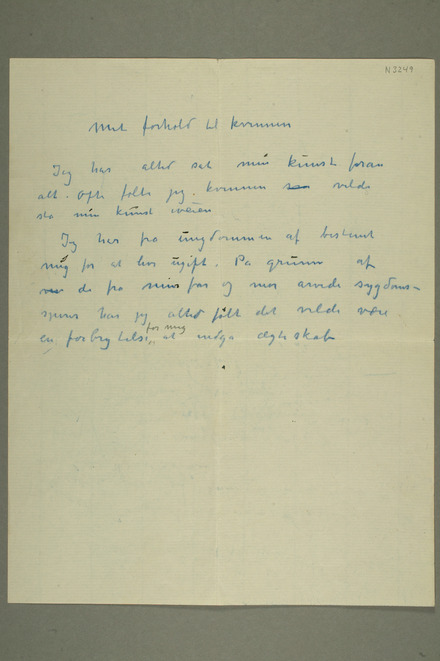
N 3249, fol. 1r |
<head rend="extraAir">Mit forhold til kvinnen</head> <p>Jeg har altid sat min kunst foran <lb/>alt. Ofte følte jeg kvinnen <del rend="overstrike">s<gap/></del> vilde <lb/>stå min kunst iveien </p> |
When the heading belongs to a list, the <head> element is placed within the <list> element.
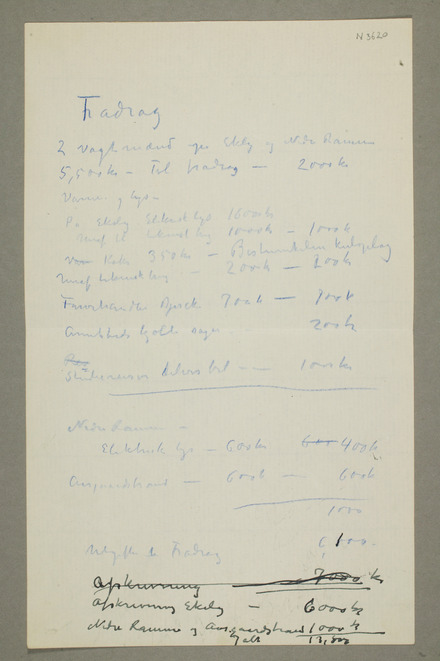
N 3620, fol. 1r |
<list> <head rend="extraAir">Fradrag</head> <item>2 vagtmænd på <placeName key="pl41">Ekely</placeName> og <placeName key="pl46">Nedre Ramme</placeName> <lb/>5,500 kr – Til fradrag – 2000 kr </item> |
3 Lists
Lists are encoded using the <list> and <item> elements.
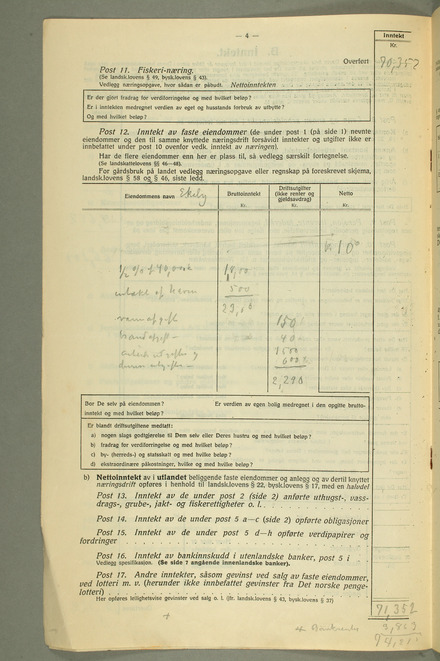
N 3563, p. 4 |
<list> <item>½ % af 40,000</item> <item>intækt af haven</item> <item>vannafgift</item> <item>brandafgift –</item> <item>arbeidsudgifter og <lb/>diverse utgifter –</item> </list> |
Lists of art works are marked with the attribute type="listOfWorks": <list type="listOfWorks">
We do not encode exhibition catalogues.
4 Tables
Tables are encoded using <table> with <row> and <cell>.
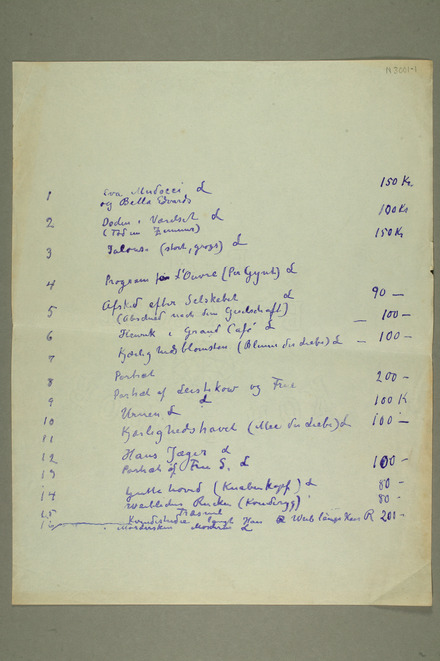
N 3001, fol. 1r |
<table n="listOfWorks"> <row> <cell>1</cell> <cell>Eva Mudocci L <lb/>og Bella Edvards</cell> <cell/> <cell>150 Kr</cell> </row> <row> <cell>2</cell> <cell>Døden i Værelset L <lb/>(Tod im Zimmer)</cell> <cell/> <cell>100 Kr</cell> </row> <row> <cell>3</cell> <cell>Jalousi (stort, grozs) L</cell> <cell/> <cell>150 Kr</cell> </row> (...) </table> |
In this example the third cell in each row is empty. Further down in the table some of the rows have fillers before the sum in the column to the right. Fillers are encoded using <cell role="filler"/> while a row without fillers has an empty <cell> element where the fillers should have been.
Horizontal bars in between the rows are encoded using the attribute rend="borderBelow" in <row>.
If a horizontal bar does not cover the complete width of the table, the attribute is placed in <cell>.
Vertical bars are encoded in <cell role="verticalBar" rend="borderLeft" rows="22"/>. The value in @rows sets how many rows the bar stretches.
Lists of works are encoded with the attribute n="listOfWorks": <table n="listOfWorks">.
The table’s heading is encoded in <head>, which is placed between <table> and <row>.
5 Columns
Columns are encoded like this:
<div type="column" rend="first">
<p></p>
<p></p>
<p></p>
</div>
<div type="column" rend="second">
<p></p>
<p></p>
<p></p>
</div>
The text’s heading is placed before the first <div type="column"> element:
<head rend="extraAir">ALFA OG OMEGA</head>
<div type="column" rend="first">
<p>ALFA OG OMEGA var de første Mennesker
<lb/>paa øen. Alfa laa i Græsset og sov
<lb/>og drømte, Omega nærmede sig ham, saa
<lb/>ham og blev nysgjerrig. Omega brød af en
<lb/>Bregnegren og kilede ham, saa han vaagnede.</p>
6 Underlined text
Munch used underlining to mark both rhetorical and typographical highlighting. We do not analyze the function of the underlining, but encode all underlined text with <hi rend="underlined">.
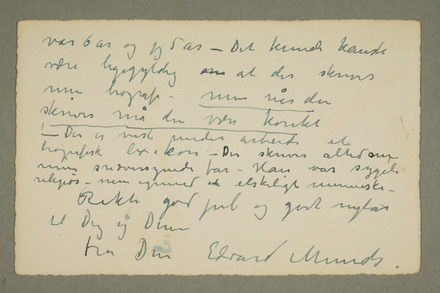
N 3647, fol. 1v |
<lb/>min biografi – <hi rend="underlined">Men når den <lb/>skrives må den være korekt</hi> |
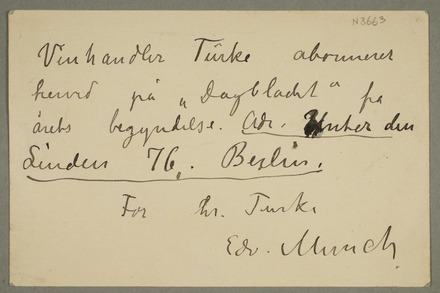
N 3663, fol. 1r |
<lb/>årets begyndelse. <hi rend="underlined">Adr. <placeName key="pl68">Unter den <lb/>Linden 76</placeName>. <placeName key="pl17">Berlin</placeName>.</hi> |
7 Raised text
Raised text is encoded using <hi rend="raised">.
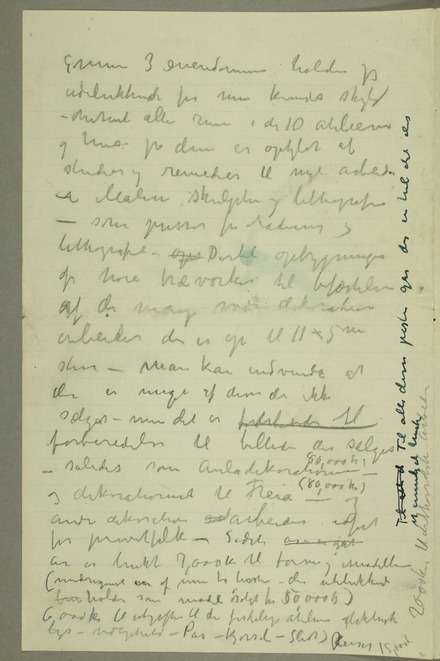
N 3591, p. 2 |
<lb/>arbeider der er op til 11 × 5<hi rend="raised">m</hi> <lb/>store – Man kan indvende at |
8 Empty lines
Empty lines are encoded using the rend attribute with a value that defines the quantity (how many lines are empty?):
- rend="extraAir": half a page or less
- rend="emptyPartOfPage": half a page or more
@rend is a global attribute and may be used everywhere. If possible, it is placed in an element just before the start of the empty space. If not, a <seg> element is added and the rend attribute is placed in <seg>:
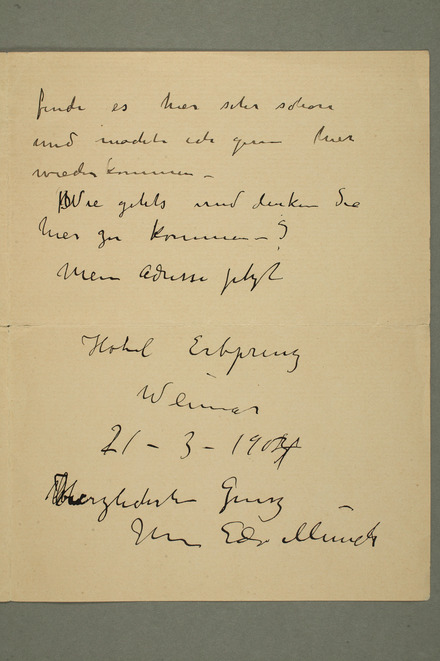
N 3204, p. 2 |
<p><seg rend="extraAir">Mein Adresse jetzt</seg> <address n="sender"><addrLine> <orgName key="i157">Hotel Erbprinz</orgName><addrLine> <addrLine><placeName key="pl30">Weimar</placeName><addrLine></address></p> |
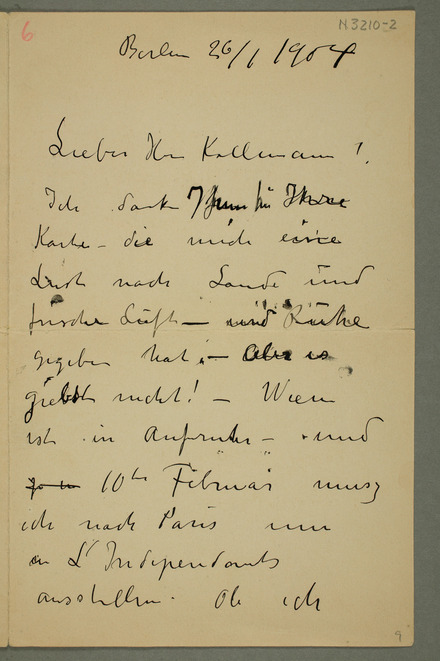
N 3210, p. 1 |
<opener> <dateline rend="extraAir"><placeName key="pl17">Berlin</placeName> <date when="1904-01-26">26/1 1904</date></dateline> <salute>Lieber Herr <persName key="pe257">Kollmann</persName>!</salute> </opener> |
Sometimes it is difficult to decide whether the space is accidental or intended (i.e. left on purpose for filling in later), cf. Intended and accidental space below, and the encoder must use her qualified judgment.
9 Intended and accidental space
We distinguish between four types of space in Munch’s texts:
9.1 Space set aside to fill later (but where the space has been left empty)
- <space dim="horizontal"/>: space in the middle of a sentence
- <space dim="vertical"/>: space between paragraphs
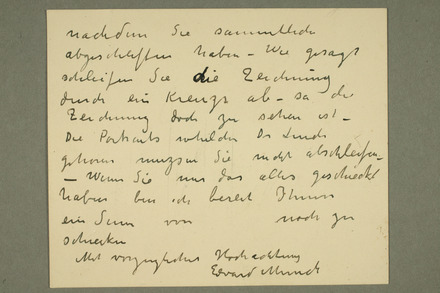
N 3451, fol. 1v |
<lb/>– Wenn Sie mir das alles geschieckt <lb/>haben bin ich bereit Ihnen <lb/>ein Sum von<space dim="horizontal"/>noch zu <lb/>schiecken</p> |
Sometimes it is difficult to decide whether the vertical space is set aside on purpose or whether the space is just “empty lines” (cf. 1.8). Qualified judgment is required.
9.2 Space that serves a purpose in the text’s structure, i.e. as replacement for punctuation
- <seg type="interpunctionalSpace"/>
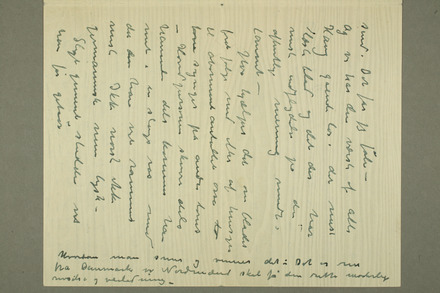
N 3127, p. 3 |
<lb/>det <del rend="overstrike">der</del> han vet rammer <lb/>mest<seg type="interpunctionalSpace"/>Ikke norsk ikke <lb/>germansk men tysk –</p> |
9.3 Space with typographical significance, i.e. the space between different blocks of text where these are on the same line (<salute> and <p> or <salute> and <signed>)
- <seg type="typographicalSpace"/>
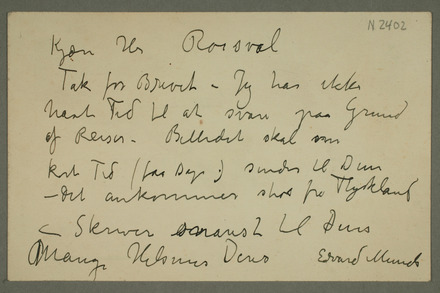
N 2402, fol. 2r |
<closer><salute><del rend="overwritten"><gap/></del>Mange Hilsener</salute> <signed rend="noLineBreakBefore"> Deres<seg type="typographicalSpace"/><persName key="pe627"> Edvard Munch</persName> </signed></closer> |
9.4 Accidental space
- <seg type="accidentalSpace"/>
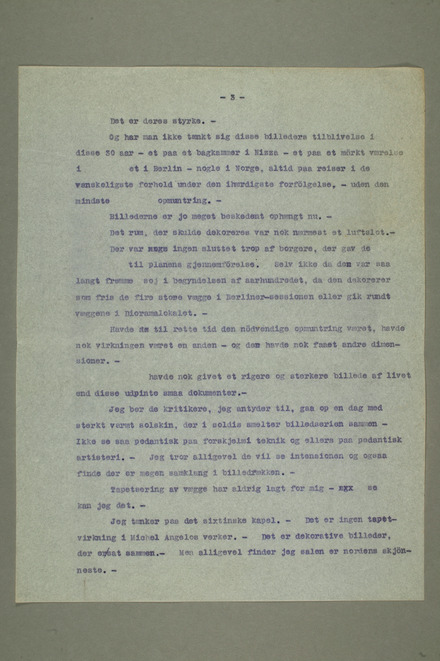
N 32, p. 3 |
<lb/>falde i styrke – Ligeledes kan<seg rend="accidentalSpace"/>toner lyde og gjenlyde gjennem <lb/>dem, skingrende toner og trommelyderne kan falde spredt. –</p> |
10 Direction of writing and text in margins
We want the visual presentation of the transcriptions to be similar to the actual manuscripts/the facsimiles. We therefore reproduce any changes in the direction of writing (i.e. text written upside down or vertically in the margin) with the help of Image Markup Tool, cf. the examples below. Our priority is the text image rather than the continuous context. Cf. chapter 3.2 Additions.
11 Pagination
Munch’s own pagination is encoded using <fw type="page">.
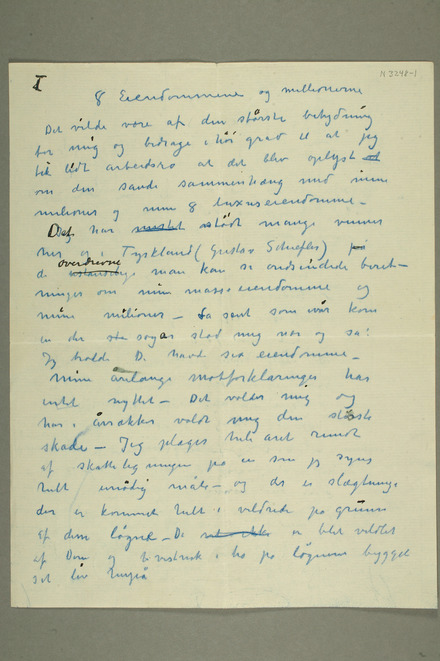 MM N 3248, fol. 1r |
<lb/><fw type="page"><handShift new="EM2"/>I</fw> <head><handShift new="EM1"/>8 Eiendommene og millionerne</head> |
12 Headers
Headers (i.e. text repeated on the top of each page) are encoded using <fw type="header">.
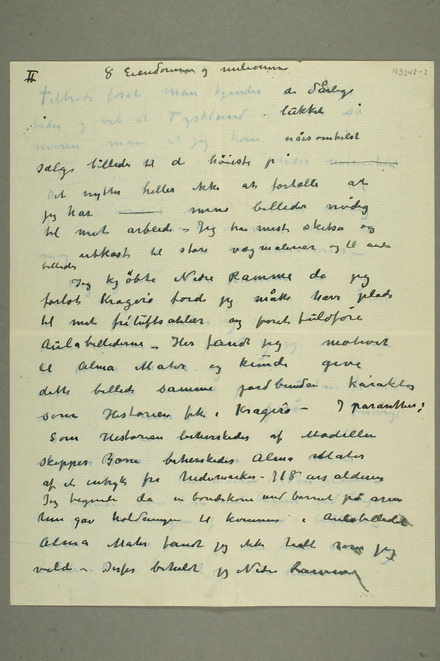 MM N 3248, fol. 1v |
<lb/><fw type="page"><handShift new="EM2"/>II</fw> <fw type="header">8 Eiendommer og milionerne</fw> |
13 Extra <div> elements
The default text structure is one chunk of text - one <div>. But sometimes we have to include an extra <div> to make the file valid. Cf. postscripts, chapter Postscripts (P.S.).
In the example below there is a horizontal bar and an unidentified chunk of text below the <closer> element. <figure> and <p> is not allowed after <closer> and we therefore encode like this:
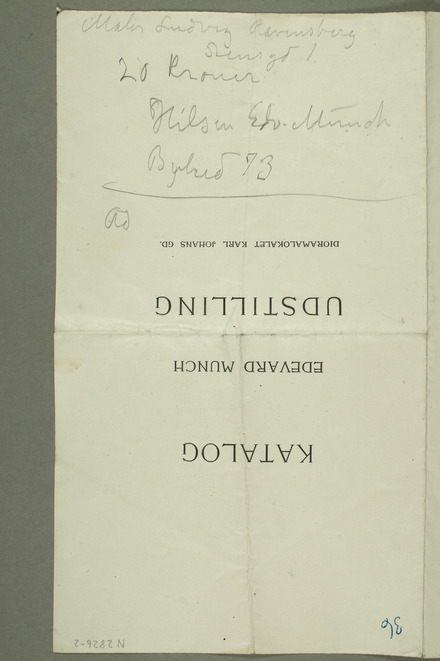 MM N 2826, p. 1 |
<div> <p><address n="recipient"><addrLine>Maler <persName key="pe392">Ludvig Ravensberg</persName></addrLine> <addrLine><placeName key="pl176">Stensgd 1</placeName>.</addrLine> </address> <lb/>20 Kroner</p> <closer><salute>Hilsen</salute> <signed rend="noLineBreakBefore"> <persName key="pe627">Edv. Munch</persName></signed> <lb/>B<del rend="overwritten">u</del>ybud 73</closer> </div> <div> <figure rend="longHorizRule"/> <p>Ad</p> </div></div></div> |
In the following example we cannot place <p> before <opener>:
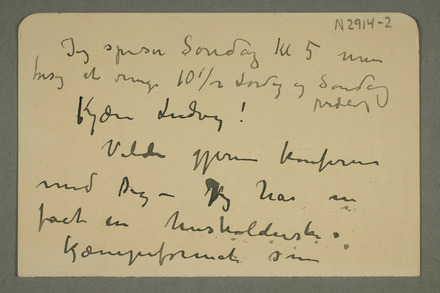 MM N 2914, fol. 2r |
<div> <p>Jeg spiser Søndag Kl 5 men <lb/>forsøg at ringe 10 ½ Lørdag og Søndag <lb/>præcis</p> </div> <div> <opener><salute>Kjære <persName key="pe392">Ludvig</persName>!</salute></opener> <p>Vilde gjerne konferere <lb/>med Dig –<del rend="overwritten">H</del>Jeg har nu <lb/>fået en husholderske i <lb/>Kæmpeformat som</p> </div></div></div> |
14 Unclear or illegible text
Munch’s handwriting is often difficult to read. We therefore read “sympathetically” and assume that the word is correctly written. Obvious misspellings are not annotated, unless the mistake makes it possible to misunderstand the meaning of the text.
14.1 Unclear text
Unclear text is encoded using the <unclear> element. The reason attribute contains information about why the text is unclear. The reason attribute is not used when the unclear text is deleted or overwritten.
- reason="damage": the manuscript is damaged
- reason="writing": the handwriting is difficult to read
- reason="blurredInk": ink stain
- reason="faintCarbonCopy": the print in the carbon copy is difficult to read
- reason="faintHectograph": the hectograph is difficult to read
- reason="faint": faint writing (ink or pencil)
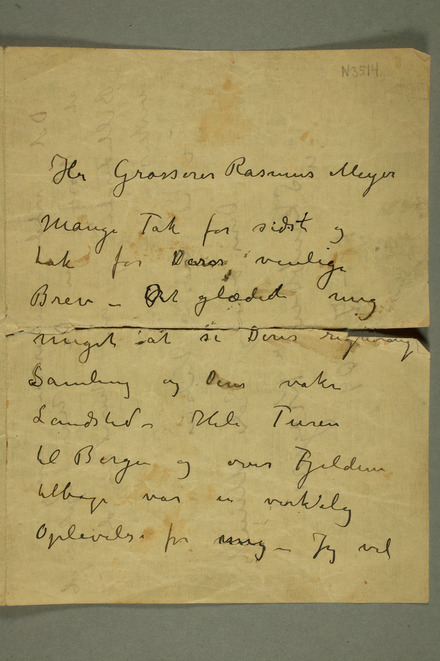 MM N 3514, p. 1 |
<lb/>meget at se Deres <unclear reason="damage">righoldige</unclear> <lb/>Samling og Deres vakre |
When a string of text is both deleted and unclear, <del> is placed within <unclear>.
14.2 Illegible text
Illegible words or phrases are encoded using the <gap> element. The reason attribute contains information about why the text is illegible.
- reason="damage": the manuscript is damaged
- reason="writing": the handwriting is impossible to read
- reason="scribble": scribble
- reason="faintCarbonCopy": the print in the carbon copy is impossible to read
- reason="faintHectograph": the hectograph is impossible to read
- reason="faint": faint writing (ink or pencil)
The reason attribute is not used when the illegible text is deleted or overwritten.
15 Edvard Munch’s corrections
15.1 Deletions
We distinguish between text that has been crossed out and text that has been overwritten.
15.1.1 Text that has been crossed out
Text that has been crossed out or erased is encoded using <del rend="overstrike">. The hand attribute is used if the deletion is done by a different hand.
We distinguish between single deleted words and phrases deleted as a whole.
Guidelines for the encoding of text (letters/words/phrases) that was intended to be deleted but that actually is not deleted:
- Only words/letters that stand completely on their own are omitted from the <del> tag, cf. example 2 (the letter “v”) below
- We include letters/words/parts of words when they are close to the deletion, cf. example 1 (the letters “tte”), 3 (the letters “føl”) and 2 (the first letter “O”)
- We include words/letters that have “avoided” the deletion stroke, but are within the “width” of the stroke, cf. example 2 (the word “han”)
Ex. 1 <del rend="overstrike">Det var sent og han måtte</del> Ex. 2 <del rend="overstrike">Om han</del> v Ex. 3 <del rend="overstrike">Den der kunde føl</del>
When a phrase has been deleted in two different rounds, we place <del> within <del>. In the example below the word “arbeid” is deleted first and then the whole line.
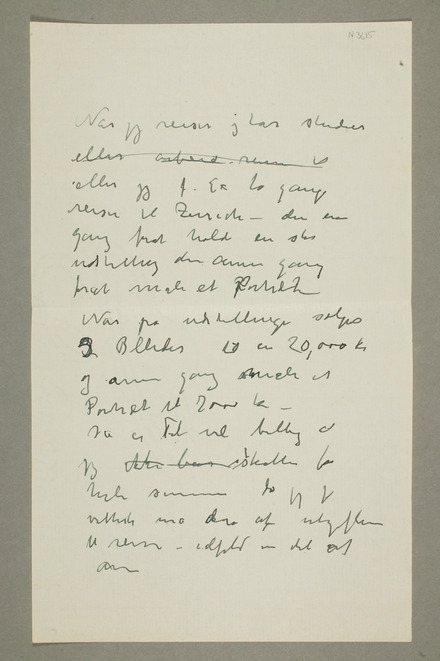 MM N 3615, fol. 1v |
<lb/>Når jeg reiser og tar studier <lb/><del rend="overstrike">eller <delrend="overstrike">arbeid</del> – reiser til</del> |
If a whole chunk of text has been deleted by a diagonal stroke, we encode using <del rend="diagonalOverstrike">.
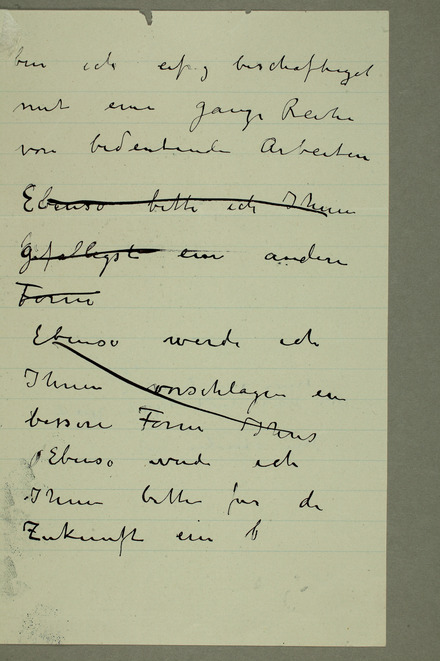 MM N 3472, p. 2 |
<p><del rend="diagonalOverstrike">Ebenso werde ich <lb/>Ihnen vorschlagen ein <lb/>bessere Form Ihres</del> <lb/>O Ebenso werde ich <lb/>Ihnen bitten fur di[e] <lb/>Zukunft ein b</p> |
15.1.2 Text that has been overwritten
Text that has been overwritten is encoded using <del rend="overwritten">.
If a word is written over another word and both words are legible, we transcribe the overwritten word in <del> and the new word just after the end tag. If only one of the words is legible, the illegible word is encoded using <gap>.
It may be difficult to distinguish between text that has been overwritten and text that has been clarified.
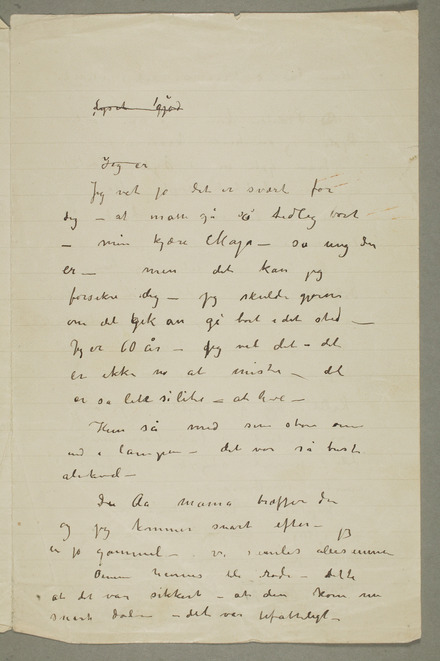 MM N 3670, p. 1 |
<lb/>om det <del rend="overwritten">k</del>gik an gå bort i dit sted – <lb/>Jeg er 60 år –<del rend="overwritten">g</del>jeg vet det – det <lb/>er ikke no at miste – det <lb/>er så lit<del rend="overwritten"><gap/></del>e så lite – at leve –</p> |
When the text has been overwritten by another writer/hand, the new text is regarded as an addition and encoded in <add>, cf. chapter 3.2:
 MM N 3620, fol. 1r |
Utgifter til Fradrag 6,<del rend="overwritten">3</del> <add hand="NN1" place="inline">1</add>00 |
15.1.3 Text that has been both overwritten and crossed out
Text that has been both overwritten and crossed out is encoded like this:
<del rend="overstrike"> <del rend="overwritten">opprinnelig ord</del>nytt ord </del>
15.2 Additions
Additions are encoded using <add place="">. The hand attribute is used if the addition is done by a different hand. (Note: With Image Markup Tool it is possible to mark an addition in the margin as a text box of its own and the text is then encoded as <p> in <div> and not as <add>.)
We use these values in the place attribute:
- place="infralinear": below the line
- place="supralinear": above the line
- place="inline": on the line
- place="inBetweenLines": between two lines
- place="margin-bot": in the footer
- place="margin-left": in the left margin
- place="margin-right": in the right margin
- place="margin-top": in the header
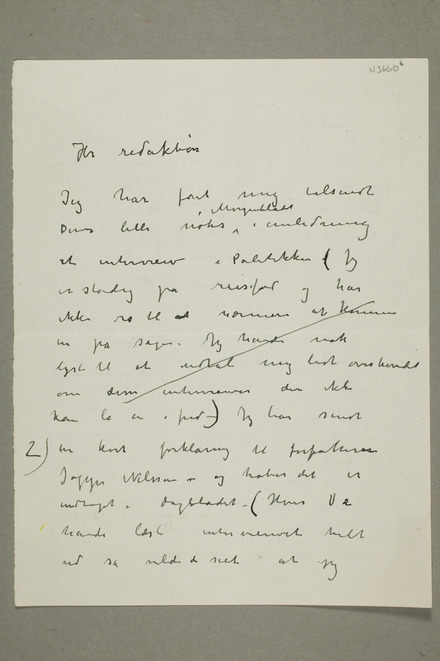 MM N 3660, fol. 1r |
<lb/>Deres lille notis <add place="supralinear">i <orgName key="i79">Morgenbladet</orgName></add> i anledning |
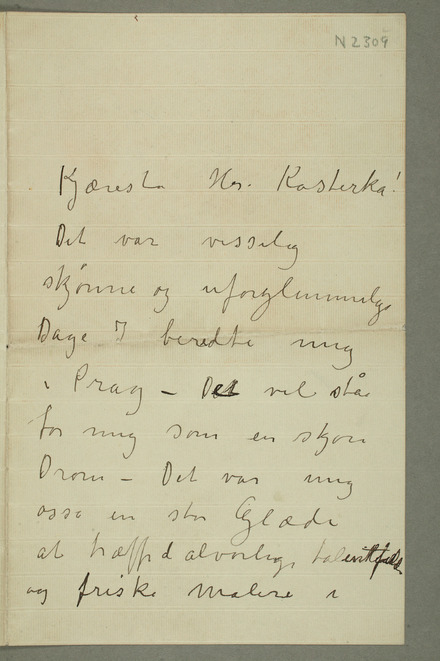 MM N 2309, p. 1 |
<lb/>skjønne og uforglemmelige <lb/>Dage I ber<add place="inline">e</add>dte mig |
Line breaks within additions are only encoded for additions in the margins or additions in between lines.
15.3 Small corrections
Some corrections are almost impossible to reproduce in the encoding. This applies to for instance corrections within punctuation, i.e. from full stop to colon, from comma or full stop to semicolon, or the correction of “a” to “å”, “o” to “ø” etc. Corrections that are impossible to transcribe and reproduce in the encoding are annotated in the editorial register, cf. chapter Carbon cop.
15.4 Document hands
We define “a new hand” to be a new scribe or the original scribe with a new ink or writing medium. The <handShift new=""/> element is placed immediately in front of the first word written by the new hand. The new attribute contains an @xml:id value from one of the <handNote> elements in <handNotes> in <teiHeader>.
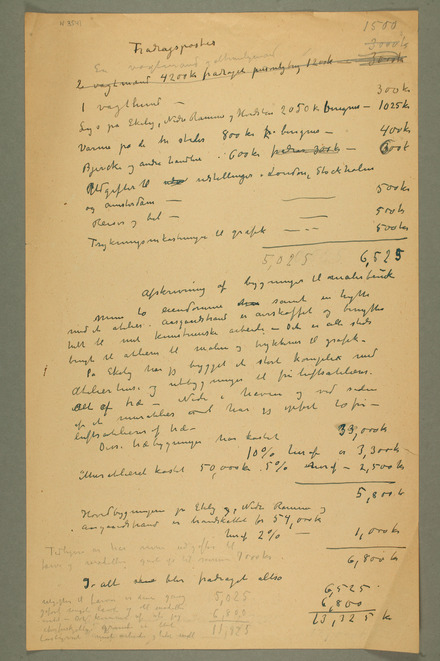 MM N 3541, fol. 1r |
<item>Hovedbygningen på <placeName key="pl41">Ekely</placeName> <del rend="overstrike">og</del>, <placeName key="pl46">Nedre Ramme</placeName> og <lb/>i <placeName key="pl42">Aasgaardstrand</placeName> er brandskattet for 54,000kr <lb/>heraf 2 % –</item> <item><handShift new="EM2"/>Tidligere år har mine udgifter til <lb/>farve og modeller gået op til sammen 7000 kr</item> <item><handShift new="EM1"/>I<gap reason="writing"></gap> alt <del rend="overstrike">sku</del> blir fradraget altså</item> <item><handShift new="EM2"/>Utgifter til farver er denne gang <lb/>påført meget lavt og til modeller <lb/>intet – Det kommer af at jeg <lb/>af forskjellige <del rend="overwritten"><gap/></del>grunde er blit <lb/>forstyrret [i] mit arbeide og lidet malt</item></list> |
As “EM1” is defined as the main hand, <handShift> is normally not necessary at the beginning of a text. However, if another hand than EM1 is responsible for the beginning of the text, <handShift> is added. In the example below, the recto page is written by an unknown hand. The verso page is written by Munch himself. Thus <handShift new="NN1"/> is placed in front of the text on the recto page and <handShift new="EM1"/> is placed in front of the text on the verso page.
15.5 Transposition
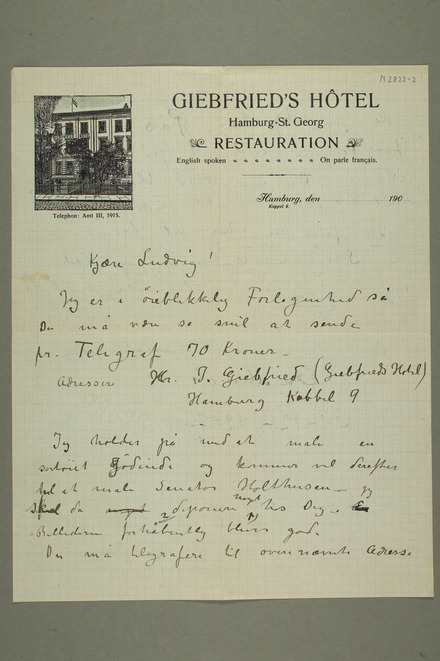 MM N 2822, fol. 2r |
<lb/>Billederne <seg type="transposition" subtype="transpText">forhåbentlig</seg> <seg type="transposition" subtype="metaMark">2</seg> <seg type="transposition" subtype="transpText">bliver</seg> <seg type="transposition" subtype="metaMark">1</seg> god. |
16 Printed and typed text
16.1 Printed text
Printed text that can be regarded as a part of the manuscript/the text, i.e. a printed “M” on French postcards or a printed letterhead (cf. the example below), is encoded using <seg type="printedText">.
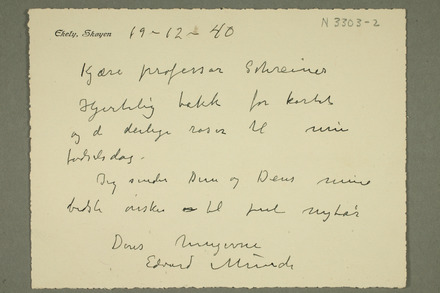 MM N 3303, fol. 2r |
<opener> <dateline rend="extraAir"> <seg type="printedText"><placeName key="pl41">Ekely</placeName>, <placeName key="pl2">Skøyen</placeName></seg> <date when="1940-12-19">19-12-40</date> </dateline> <salute>Kjære professor <persName key="pe627">Schreiner</persName> </salute> </opener> |
Whole printed texts are transcribed and encoded in the usual way, but with the attribute type="printedText" in the first <div> element.
16.2 Typed text
We transcribe and encode typed text. If Munch himself has typed (or dictated) the text, we use the “hand” xml:id="EM1". For typed telegrams we use xml:id="NN1".
Handwritten corrections and additions are encoded the usual way and described in <handNotes>.
<handNotes> <handNote xml:id="EM1" medium="typed">Maskinskrevet.</handNote> <handNote xml:id="EM2" medium="pen_black">Svart blekk.</handNote> </handNotes>
Spaced text is encoded using the <emph> element (and the spacing itself is not reproduced).
17 Normalization
17.1 Characters that cannot be transcribed
Sometimes Munch has started writing the wrong letter and then stopped half way through without deleting it. As the letter is not complete, we cannot transcribe it and usually it is hard to identify which letter it was supposed to be. The character is meaningless and it is therefore omitted from the transcription.
If, on the other hand, the character is visually prominent, disturbing or potentially meaningful, it should be encoded as illegible text in <gap reason="writing"/> or <gap reason="scribble"/>.
17.2 Abbreviations
Abbreviations are transcribed character by character (we do not normalize blanks and punctuation).
17.3 Scribbles
Scribbles are not transcribed character by character but described using the annotation category “philologicalNotes”. In the example below, the signature “Edvard Munch” in the upper right corner is encoded as usual. The surrounding scribbles are described.
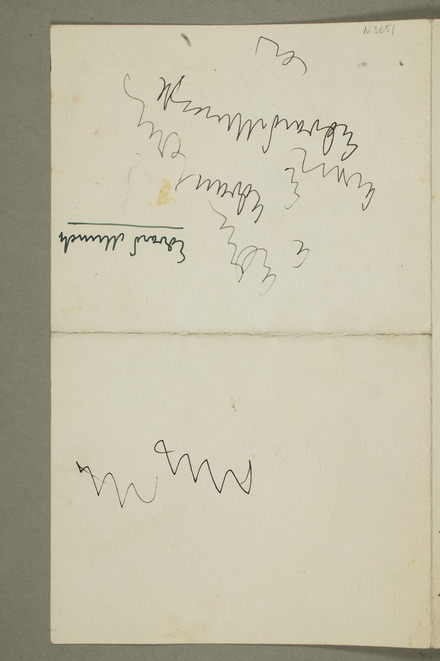 MM N 3651, p. 4 |
<div xml:id="imtImageAnnotations"> <div corresp="#imtArea_0" type="imtAnnotation"><head>1</head> <div><p><hi rend="underlined"><persName key="pe627">Edvard Munch</persName></hi></p></div></div> <div corresp="#imtArea_1" type="imtAnnotation"><head>Filologisk note</head> <div><p>Skriblerier, hele eller deler av navnet Edvard Munch.</p></div> |
17.4 Calculations
We do not normally transcribe calculations (although we sometimes do). Summation lines are encoded using the element <seg rend="calculationLine"/>.
<figure rend="calculationLine"/>
17.5 Separations lines
Separation lines (bars) are encoded using an empty <figure/> element. The rend attribute is used for describing the length of the bar:
rend="shortHorizRule" rend="longHorizRule"
Summation lines are encoded using the element <seg rend="calculationLine"/>.
 MM N 3620, fol. 1r MM N 3620, fol. 1r
|
<item><del rend="overstrike">Reis</del> <lb/>Studiereiser delvis bil – – 1000 kr <figure rend="longHorizRule"/></item> <item><placeName key="pl46">Nedre Ramme</placeName> – <lb/>Elektrisk lys – 600 kr <del rend="overstrike">600</del> 400 kr</item> <item><placeName key="pl42">Aasgaardstrand</placeName> – 600 k – 600 kr <figure rend="calculationLine"/></item> <item>1000</item> |
17.6 Clarification
Clarifications are normally not encoded, but are in some texts annotated in the editorial register, cf. chapter Carbon cop.
Clarification is not a correction, but rather an attempt to make the writing clearer and more readable.
It can be difficult to distinguish between overwritten and clarified text, cf. chapter 3.1.2.
17.7 Dates with raised text
Dates like “12/12” (where the month is raised) is normalized to “12/12” in the transcription.
17.8 Centered and right-aligned text
We usually do not mark how the text is aligned on the page. However, we sometimes use <seg type="typographicalSpace"/> to reproduce an extra typographic indent.
18 Characters
18.1 Hyphens
All hyphens are reproduced as normal hyphens. Hyphens are always placed before the line break (even though Munch often placed them after the line breaks). Double hyphens are transcribed as normal hyphens.
18.2 Fillers
In lists, fillers are encoded using <seg type="filler"/>. In tables, they are encoded using <cell role="filler"/>.
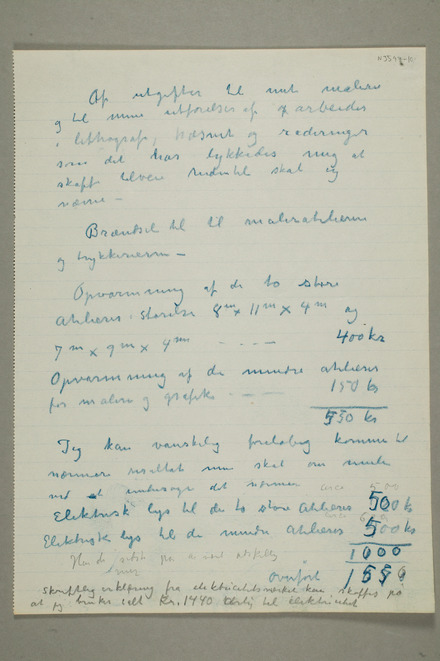 MM N 3597, fol. 10r |
<item>Opvarmning af de to store <lb/>atelierer i størelse 8<hi rend="raised">m</hi> x 11<hi rend="raised">m</hi> x 4<hi rend="raised">m</hi> og <lb/>7<hi rend="raised">m</hi> x 9<hi rend="raised">m</hi> x 4<hi rend="raised">m</hi> <seg type="filler"/> 400 kr</item> <item>Opvarming af de mindre atelierer <lb/>for maleri og grafik <seg type="filler"/> 150 kr |
18.3 Entities
- Dash, –, i.e. –
- We use dashes in time spans such as “1892–93” (1892–93) and other spans such as “Oslo–Bergen–Åndalsnæs” (Oslo–Bergen–Åndalsnæs).
- Quotation marks, « and », i.e. “ and ”
- Check mark, ✓, i.e. ✓
- Sometimes Munch has used a check mark to mark that the item on a list has been dealt with. The appearance of these marks differs from text to text and the marks are placed above, below or in between the lines. We normalize and transcribe the check mark either in the beginning of the line (after the number/bullet) or at the end.
- Ditto mark, 〃, i.e. 〃
- Apostrophe, ’, i.e. ’
- Degree sign, °, i.e. °
- (French) œ and Œ, œ and Œ
- (French) ç and Ç, ç and Ç
- (German) ß, ß
- Multiplication sign, ×, ×
- White square, □, i.e. □
- Fractions
- ¼, i.e. ¼
- ½, i.e. ½
- ¾, i.e. ¾
- ⅓, i.e. ⅓
- ⅔, i.e. ⅔
- ⅕, i.e. ⅕
- ⅖, i.e. ⅖
- ⅗, i.e. ⅗
- ⅘, i.e. ⅘
- ⅙, i.e. ⅙
- ⅚, i.e. ⅚
- ⅛, i.e. ⅛
- ⅜, i.e. ⅜
- ⅝, i.e. ⅝
- ⅞, i.e. ⅞
- ⅟, i.e. ⅟. For fractions without specific entities, we use ⅟ in combination with small numbers.
19 Notes
19.1 Temporary notes
Temporary notes are placed in front of the word/phrase the note is about.
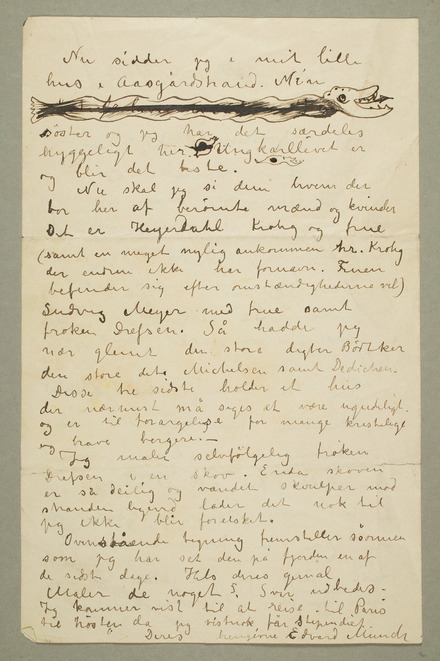 MM N 3678, fol. 1v |
<lb/>frøken <note>er dette Gudrun Drewsen (id646)? Næss (s. 89) skriver at Munch skal ha malt en frøken Drewsen (dansk) sommeren 1889.</note> <persName key="">Drefsen</persName>. Så hadde jeg <lb/>nær glemt den store digter <note>er dette Sigurd Bødtker (id66)?</note> <persName key="">Bødtker</persName> |
19.2 Inscriptions and original notes
19.2.1 Munch’s notes
Munch’s inscriptions and notes are encoded as additions (<add>). Reference marks are normalized to * (asterisk) and encoded in <ref> with @xml:id or @target.
The reference mark within the text is encoded like this:
<ref type="note" xml:id="n1">*</ref>
The note (with reference mark) is encoded like this:
<add place=""><ref type="note" target="n1b">*</ref>[added text]</add>
<lb/>tar sig ut<ref type="note" xml:id="n1">*)</ref> – Det beste er du
<lb/>sender mig tegningen tilbage
<lb/>med Dine bemærkninger –
<lb/>Muligens jeg kunde forbedre den –
<lb/><add place="margin-bottom"><ref type="note"
target="n1b">*)</ref>Altså <del rend="overwritten"><gap/></del>send
mig prøvetryk</add>
19.2.2 Inscriptions and notes added by others
We only include inscriptions and notes that are relevant to Munch’s text. The hand is marked by a <handShift/> element in the beginning of the inscription or by the hand attribute in <add>. Inscriptions and notes that are not encoded are described (“Not EM’s handwriting”) in Image Markup Tool.
Notes added by people other than Munch are regarded as commentaries to the text and encoded in <note>. >). Reference marks are normalized to * (asterisk) and encoded in <ref> with @xml:id or @target.
The reference mark within the text is encoded like this:
<ref type="note" xml:id="n1">*</ref>
The note (with reference mark) is encoded like this:
<add place=""><ref type="note" target="n1b">*</ref>[added text]</add>
<p>–<ref type="note" xml:id="n1">
<handShift new="IM1"/>*</ref> <handShift new="EM1"/>Min hjertesøster lykkedes
det at <add place="supralinear">få</add> fastslåt
<lb/>at jeg har arvet min malerævne gjennem
<lb/>morsiden – I <persName key="pe137">Gauguins</persName> bok
får <del rend="overwritten"><gap></gap></del>hun
<lb/>sagt at all sjæleligt er kommet fra
<lb/><del rend="overwritten"><gap></gap></del>morsiden –
Det blir ikke stort igjen fra
<lb/>Munchesiden – Det er en gammel liten
<lb/>familietvist hun her <del rend="overwritten"><gap></gap></del>har fåt afgjort
<lb/>på en praktisk måte – <add hand="EM2" place="inBetweenLines">Vi 3
ældste var Munchianere <ref type="note" xml:id="n2"><handShift new="IM1"/>*</ref>
<lb/><handShift new="EM2"/>medens “småpikerne” var Bjølstadianere –</add></p>
In this text Inger Munch “elaborates” her brother’s statements in a letter to Jens Thiis. The example is a bit special: Firstly, Inger has signed her comment and as <closer> is not allowed inside <note>, we have to include the extra elements <floatingText>, <body>, <div> and <p> within <note> to make the file valid. Secondly, she has added two reference marks, but only one note. Only the first mark is linked to the note.
<p>Det er det eneste mulige forat jeg
<lb/>kan hjælpe med arbeidet</p>
<lb/><note resp="IM1"><floatingText><body><div><p rend="noLineBreakBefore">
<ref type="note" target="n1b"><handShift new="IM1"/>*</ref>Jeg har aldrig talt med
<persName key="pe137">Gaugin</persName> før efter min
<lb/>brors død. Jeg har vært forarget over flere av hans
<lb/>uttalelser i boken, jeg har beklaget at han ikke
<lb/>har talt med mig før han skrev boken. Jeg har
<lb/>aldrig sagt at <persName key="pe627">Edvard</persName> har sin sjelelige innstilling
<lb/>fra mo<unclear reason="writing">r</unclear>sslekten. Sannheten er at
engang jeg talte</p></div></body></floatingText></note>
<lb/><note resp="IM1"><floatingText><body><div>
<p rend="noLineBreakBefore">med fru <persName key="pe368">Aase Nørregaard</persName>
fortalte jeg henne
<lb/>hvad min bror har sagt om min tante: “Tante
<lb/>hadde blitt en stor kunstnerinne hvis hun hadde
<lb/>reist ut og satt sig inn i kunsten.” Fru <persName key="pe368">Nørre-
<lb/>gaard</persName> svarte mig: “Derfor er han blitt sånn ene-
<lb/>stående kunstner, han slekter på to familier.”
<lb/>Min tante og <persName key="pe452">Jørgen Sørensen</persName> hadde en del felles.
<lb/><persName key="pe452">Jørgens</persName> <del rend="overwritten"><gap></gap></del>mor
var født Holm, og min mors <del rend="overstrike">mormor</del><add place="supralinear">mor</add>
<lb/>var født Holm. – Der har vært en del <unclear reason="writing">skumleri</unclear>
<lb/>blant vår slekt. Og meget er kommet frem til
<lb/>min bror på en usannfærdig måte.</p>
<closer><signed><persName key="pe348">Inger Munch</persName>.</signed></closer>
</div></body></floatingText></note>
20 Genre-specific encoding
20.1 Letters
20.1.1 Opener
The opening parts are encoded in <opener> and normally include date and opening salutation: <dateline> and <salute>. <opener> may also include an <address> and various other text strings that cannot be defined as date, place or salutation, cf. Addresses.
20.1.2 The letter text
The main parts of the letter are encoded in <p> elements.
20.1.3 Closer
The closer includes salutation, signatures and dates and is encoded in the <closer> element with <salute>, <signed> and <dateline>. <closer> may also include an <address> and various other text strings that cannot be defined as date, place or salutation, cf. Addresses.
Note that <signed> may include a “signature greeting” as well as the actual signature, i.e. phrases like “Deres hengivne...”, “Din...”, “Deres særdeles forbundne” etc.
<closer><salute>Med venligste hilsen</salute> <signed>Deres hengivne> <persName key="pe627">Edv. Munch</persName></signed></closer>
20.1.4 Postscripts (P.S.)
Postscripts (text written after the signature) are encoded in <div type="postscript">, with one or more <p> elements and possibly <opener> and <closer>. The “p.s.” itself is encoded in <label>.
<body>
<div xml:id="imtImageAnnotations"><div corresp="#imtArea_0"
type="imtAnnotation"><head>1</head><div>
<div type="letterpart">
<p rend="noIndent">Jeg kommer da indom <placeName key="pl22">Kjøbenhavn</placeName></p>
<closer><salute>Mange hilsener</salute>
<signed>Din hengivne</signed>
<signed><persName key="pe627">Edvard Munch</persName></signed>
<dateline><placeName key="pl2">Skøien</placeName> <date when="1920-06-10">
1<del rend="overwritten">8</del>0-6-1920</date></dateline></closer></div>
<div type="postscript">
<p>La mig få høre fra Dig
<lb/>Hvordan var <persName key="pe399">Roedes</persName>
stykke<unclear reason="writing">?</unclear></p></div>
</div></div></div>
</body>
<body>
<div xml:id="imtImageAnnotations"><div corresp="#imtArea_0"
type="imtAnnotation"><head>1</head>
<div type="postscript">
<p>Ich habe Ihnen vorgeschlagen das
<lb/>Portrait Familien Warburg in
<lb/><placeName key="pl17">Berlin</placeName> auszustellen aber habe
<lb/>kein Antwort bekommen in diese
<lb/>Gelegenheit</p>
<label>P S.</label>
</div></div></div>
</body>
20.1.5 Addresses
Addresses usually occur on envelopes. The address is encoded in <p> and <address n="">. In @n we put either “sender”, “recipient” or “discussed”. Each address line is encoded in <addressLine>. Names (persons, organizations and places) are also encoded.
Sometimes Munch wrote the address (the recipient’s and/or his own) on the actual letter as well. The address is encoded as usual in <address n="">, but placed inside either <opener> or <closer>.
20.1.6 Example: letter and envelope
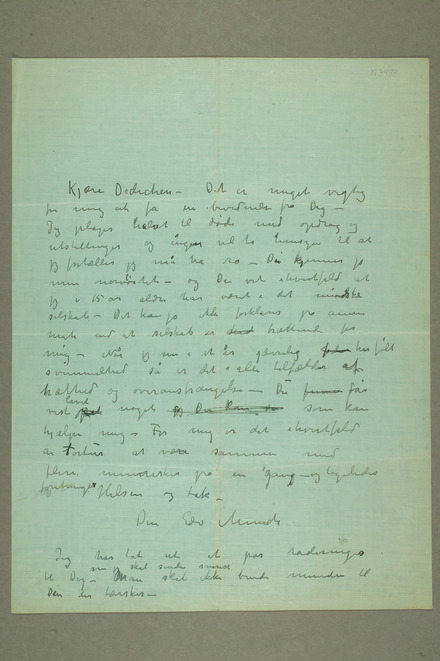 MM N 3488, fol. 1r |
<opener><salute>Kjære <persName key="pe79">Dedichen</persName> –</salute> </opener><p rend="noLineBreakBefore">Det er meget vigtig <lb/>for mig at få en bevidnelse fra Dig – <lb/>Jeg plages h<del rend="overwritten"><gap/></del>alvt til døde med opdrag og <lb/>utstillinger og ing<del rend="overwritten"><gap/></del>en vil ta hensyn til at <lb/>jeg fortæller jeg må ha ro – D<del rend="overwritten"><gap/></del>u <del rend="overwritten"><gap/></del>kjenner jo <lb/>min nervøsitet – og Du vet ihvertfald at <lb/>jeg i 15 år aldri har været i det min<del rend="overwritten"><gap/></del>dste <lb/>selskab – Det kan jo ikke forklares på annen <lb/>måte end at selskab er <del rend="overstrike">skad</del> trættende for <lb/>mig – Når jeg nu i et år jævnlig <del rend="overstrike">føler</del> har følt <lb/>svimmelhed så er det i alle tilfæld<del rend="overwritten"><gap/></del>er af <lb/>træthed og overanstrængelse – Du <del rend="overstrike">finner</del> får <lb/>vist <add place="supralinear">lavet</add> <del rend="overstrike"><gap/>et</del> noget <del rend="overstrike">jeg Du kan so</del> som kan <lb/>hjælpe mig – For mig er det ihvertfald <lb/>en <del rend="overwritten"><gap/></del>tortur at væ<del rend="overwritten"><gap/></del>re sammen med <lb/>flere menn<del rend="overwritten"><gap/></del>esker på en gang – <add place="inBetweenLines">og ligeledes <lb/><del rend="overwritten">V</del>foretninger.</add></p> <closer rend="extraAir"><salute>Hilsen og tak –</salute> <signed>Din <persName key="pe627">Edv Munch</persName></signed></closer> <postscript><p>Jeg har tat ut et par raderinger <lb/>til Dig – <add place="supralinear">som jeg skal sende snarest</add> – <del rend="overwritten"><gap/></del> Man skal ikke binde munden til <lb/>Den der hærsker –</p></postscript> |
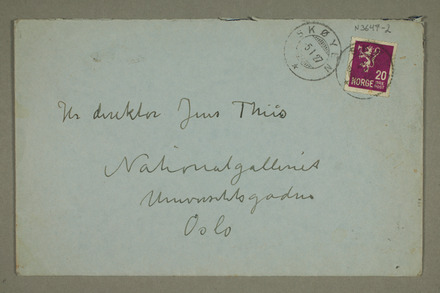 MM N 3647, fol. 2r |
<p><address n="recipient"><addrLine>Hr direktør <persName key="pe458">Jens Thiis</persName></addrLine> <addrLine><orgName key="i84">Nationalgalleriet</orgName></addrLine> <addrLine><placeName key="pl74">Universitetsgaden</placeName></addrLine> <addrLine><placeName key="pl20">Oslo</placeName></addrLine></address></p> |
20.2 Drama
We use these drama-specific elements:
- <sp>: speech (with <p> elements inside)
- <speaker>: the speaker
- <stage>: stage direction
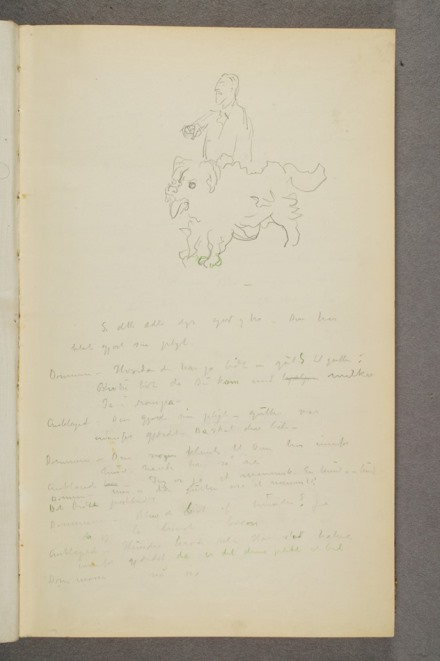 T 2849, fol. 1r |
<sp><p>Se dette ædle dyr god og tro – Den har <lb/>blot gjort sin pligt –</p></sp> <sp><speaker>Dommeren</speaker><p>– Hvordan den har jo bidt en gut? <stage>til gutten:</stage> <lb/>Blev Du bidt da Du kom med hjælp melken</p></sp> <sp><p>Ja i rompa –</p></sp> <sp><speaker>Anklagede</speaker><p>– Den gjorde sin pligt – gutten var <lb/>innenfor gjærdet – Da skal den bide –</p></sp> <sp><speaker>Dommeren</speaker><p>– Om nogen klinte til Dem her innenfor <lb/>huset, havde han så ret</p></sp> <sp><speaker>Anklagede <del rend="overstrike"><gap reason="writing"/></del></speaker><p>– Jeg er jo et menneske. En hund er en hund</p></sp> <sp><speaker>Dommeren</speaker><p>– Men er ikke gutten også et menneske?</p></sp> <sp><speaker>Det bidte postbud:</speaker><p/></sp> <sp><speaker>Dommeren</speaker><p>– Blev du bidt af hunden?</p></sp><sp><p>Ja <lb/>da jeg la brevet i boxen</p></sp> <sp><speaker>Anklagede</speaker><p>– Hunden havde ret – Han stod halvt <lb/>innenfor gjærdet da er det dens pligt at bide</p></sp> <sp><speaker>Dommeren</speaker><p>– nå nå</p></sp> |
Incomplete “speeches”, where either the speaker or the speech is missing, are encoded like this:
<sp><speaker>Det bidte postbud:</speaker><p/></sp>
<sp><p>Ja i rompa –</p></sp>
20.3 Verse
Stanzas are encoded in <lg> elements, verse lines are encoded in <l> elements.
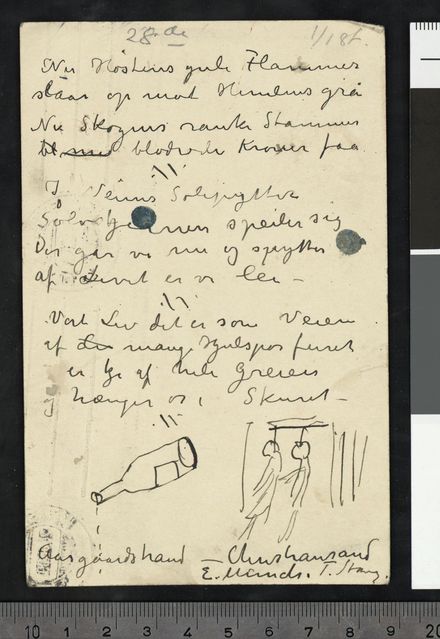 PN 731, p. 2 |
<lg><l>Nu Høstens gule Flammer</l> <l>slaar op mod Himlens grå</l> <l>Nu Skogens ranke Stammer</l> <l><del rend="overstrike">bl</del> <del rend="overstrike">med</del> blodrøde Kroner faa</l></lg> |
21 For searching
21.1 Dates
Dates are encoded using <date> with the when attribute. The date (yyyy-mm-dd) is placed in @when. Any unknown part of a date is replaced by a hyphen.
- Year only, i.e. '1892', <date when="1892">
- Year and month, i.e. 'Febr. 1892', <date when="1892-02--">
- Year, month and day, i.e. '11/2 92', <date when="1892-02-11">
- A period, i.e. 1892–93, <date from="1892" to="1893">
21.2 Organizations
Organizations are encoded like this: <orgName key="">[the name of the organization]</orgName>. The attribute value in @key is: i + the id-value from the name register.
21.3 Persons
Personal names are encoded like this: <persName key="">[the name of the person]</persName>. The attribute value in @key is: pe + the id-value from the name register. If the name is a genitive, i.e. “Vigelands”, the whole word is placed within the <persName> tag.
21.4 Place names
Place names are encoded like this: <placeName key="">[the name of the place]</placeName>. The attribute value in @key is: pl + the id-value from the name register.
21.5 Commentary
Comments are encoded using <ref type="lemma" target="">[the word/phrase the commentary is about]</ref>. >. The attribute value in @target is: co + the id-value from the commentary database.
22 The annotation category “textForSearch”
With the Image Markup Tool, we can mark the whole or parts of a document image with the annotation category “textForSearch”. This is text we want to make searchable, but do not transcribe character by character.
22.1 <date when=""/>
Date. Instead of transcribing the actual date we encode it in the when attribute in an empty <date> element.
22.2 <orgName key="i…"/>
Name of organization. Instead of transcribing the actual name we encode it in the key attribute in an empty <orgName> element.
22.3 <persName key="pe…"/>
Personal name. Instead of transcribing the actual name we encode it in the key attribute in an empty <persName> element.
22.4 <placeName key="pl…"/>
Place name. Instead of transcribing the actual name we encode it in the key attribute in an empty <placeName> element.
23 Drawings
Drawings and sketches are marked with the annotation category “commentary”. Titles or other text blocks belonging to the drawing are encoded in <p> elements.
<body>
<div xml:id="imtImageAnnotations"><div corresp="#imtArea_0" type="imtAnnotation"><head>1</head>
<div><p rend="noIndent">mennesker der har hus<del rend="overwritten"><gap></gap></del>ket på
<lb/>mig og så vanlige forretnings-
<lb/>mæssige ting –</p>
<p rend="emptyPartOfPage">Det blir vist ikke
<lb/>muli for mig at bo på <placeName key="pl41">Ekely</placeName>
<lb/>– Jeg skal huske på hva
<lb/>vi aftalte når jeg kommer til
<lb/>ro –</p>
</div></div><div corresp="#imtArea_1" type="imtAnnotation"><head>Tegning</head>
<div><p>Vandringsmanden</p>
</div></div><div corresp="#imtArea_2" type="imtAnnotation"><head>2</head><div>
<p>Slig sniger jeg mig lønli af og
<lb/>til ind på <placeName key="pl41">Ekely</placeName> –</p>
<closer><salute>Mange hilsener og gode ønsker <del rend="overstrike">for</del> om
<lb/>godt år</salute> <signed rend="noLineBreakBefore">Deres
<persName key="pe627">Edvard Munch</persName></signed></closer>
</div></div></div>
</body>
24 Miscellaneous
24.1 Mottos
Mottos are encoded using the <epigraph> tag with a <p> tag inside.
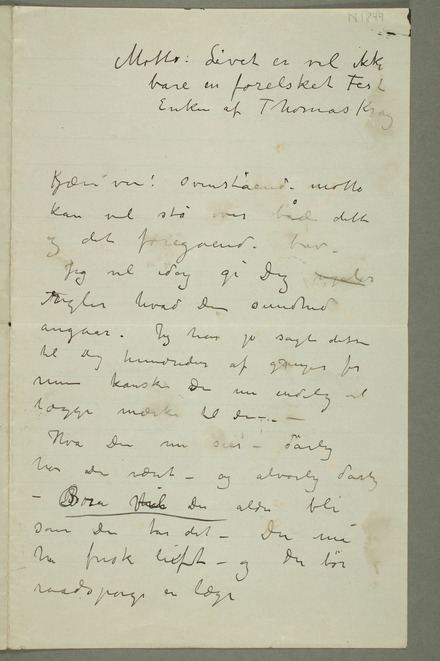 MM N 1849, p. 1 |
<epigraph rend="extraAir"> <p>Motto: Livet er vel ikke bare <lb/>en forelsket Fest <lb/>Enken af <persName key="">Thomas Krag</persName></p> </epigraph> <opener rend="noLineBreakAfter"><salute>Kjære ven!</salute></opener> <p rend="noLineBreakBefore">Ovenstående motto |
24.2 Long s
In gothic handwriting there are two forms of miniscule s, one normal short and one so-called “long s”. Norwegian schoolchildren learned gothic until about 1860. Munch must have known both gothic and Latin handwriting. Although he normally used Latin handwriting, he sometimes used the long p. We transcribe the long s as a normal short s, but add a comment about the phenomenon.
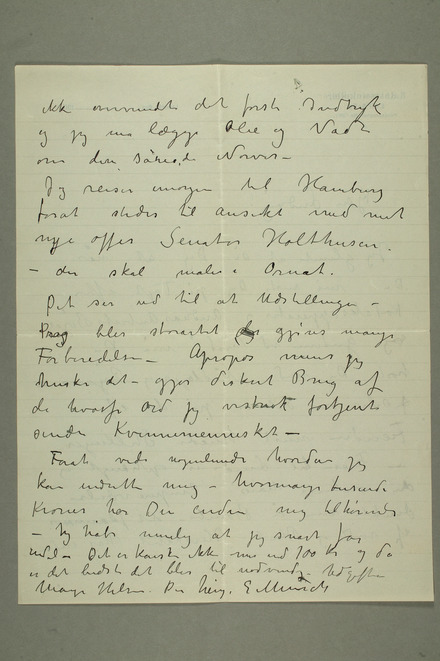 MM N 2819, fol. 2v |
<lb/>de hvas<ref type="lemma" target="co67">s</ref>e ord jeg vistnok fortjent <lb/>send<unclear reason="writing">te</unclear> Kvinnemennesket –</p> |
In texts where the long s occurs more frequently, we add a general description of the phenomenon in the general introduction to the text.
24.3 Nasal stroke
The nasal stroke is an abbreviation where a horizontal bar is placed above an m or an n to mark the duplication of the letter. This abbreviation was much used in manuscripts. We expand the abbreviation (mm/nn), but add a comment.
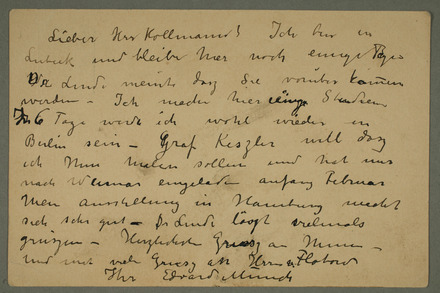 MM N 3209, fol. 1r |
<lb/><del rend="overwritten"><gap/></del>Dr <persName key="pe301">Linde</persName> meinte dasz Sie vorüber k<del rend="overwritten"><gap/></del> o<ref type="lemma" target="co71">mm</ref>en |
24.4 Carbon copies
There are some carbon copies among Munch’s texts.
In some cases we have both an original and a copy. Only the original is encoded, the identical carbon copy is marked as “philologicalNotes” with a comment. Only the original hand is noted in <handNote>.
Munch has sometimes changed or clarified some of the text in the copy. This is called fixation. Small clarifications are noted in the editorial register, but not encoded. More substantial corrections and clarifications on copies are encoded.
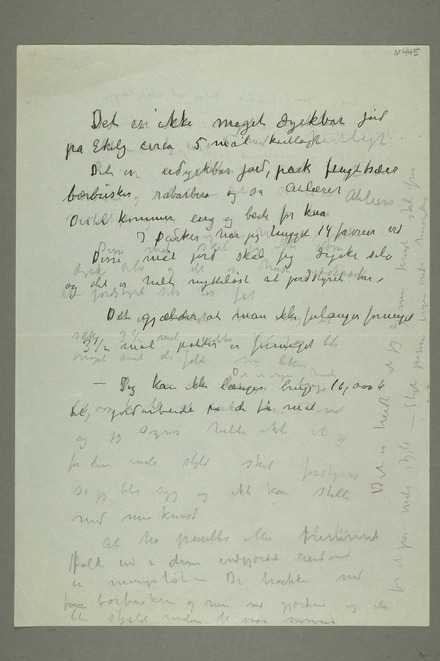
MM N 445, fol. 1r
24.5 Layers of text
In some of the texts, we encounter more than one layer of text. In the example below we can identify three different hands or layers: one grey pencil, one purple pen and then some of the pencil is overwritten by a black pen. To be able to reproduce the text in a diplomatic way, we have decided to encode the overwritten text (pencil + additions and corrections made by the purple pen) in its own text box. The text is also described in the editorial register.
24.6 Philological encoding
24.6.1 Notes
Philological and editorial notes that we want to keep “forever”, but not show, are encoded in <note resp="editor">.


